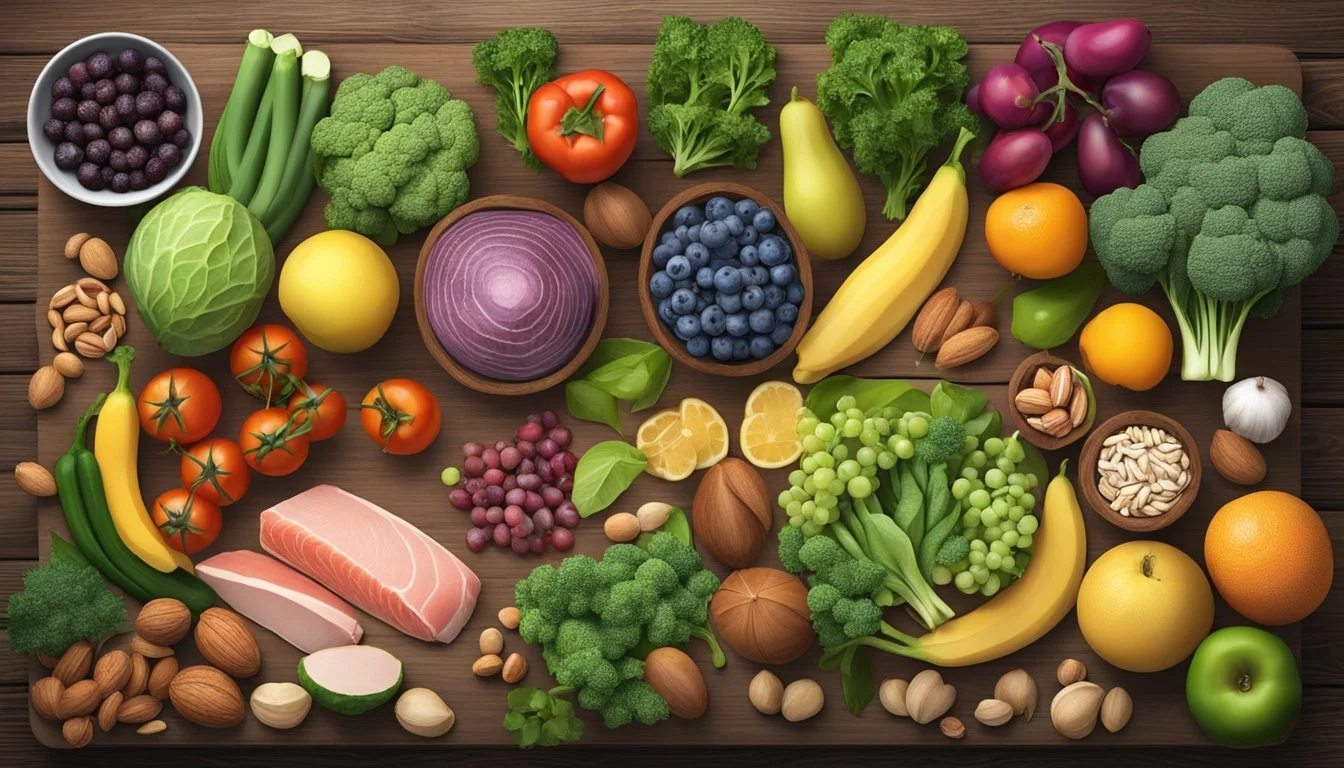The Paleo Diet
Uncover Modern Health Lessons from Our Ancestors' Foods
The Paleo Diet draws inspiration from the dietary patterns of ancient humans, advocating for a nutritional plan based on foods presumed to have been consumed by our Paleolithic ancestors. This approach to eating typically emphasizes high protein intake and a reduction in carbohydrates, excluding foods that emerged after the advent of agriculture, such as dairy products, legumes, and grains. Proponents suggest that by mirroring the eating habits of early humans, modern individuals may sidestep chronic health issues that are often associated with Western diets.
A look back into the archaeological records, including findings from places like the Shanidar Cave, indicates that our ancestors' diets may have been more diverse than the modern interpretation of the Paleo Diet suggests. These early populations consumed a wide array of plants and animals, highlighting an adaptability to their environment. The diversity and the nutritional content of their foraged and hunted food likely played a role in human evolution, with natural selection favoring traits that provided survival advantages in response to the available food sources.
In considering the Paleo Diet within the context of modern health, it is crucial to examine the link between ancient eating habits and contemporary lifestyles. As modern diseases such as diabetes, cancer, and cardiovascular issues proliferate, some researchers posit a dissonance between our evolutionary dietary patterns and today's common food consumption. Placing a lens on ancient foods and evolutionary nutrition may offer insights into crafting diets that align more closely with human biology, potentially mitigating the prevalence of diet-related health conditions.
Origins of the Paleo Diet
The Paleo Diet is rooted in the presumption that human genetics have scarcely changed since the dawn of agriculture, and thus, modern humans might benefit from a diet resembling that of the Paleolithic era.
Evolutionary Perspective
Evolutionary theory posits that the diet of early humans was perfectly attuned to their biology. Proponents of the Paleo Diet suggest that the drastic changes in diet over the last 10,000 years are out of sync with human evolution. They argue that the advent of agriculture introduced foods that humans were not genetically adapted to consume.
Paleolithic Era Dietary Habits
During the Paleolithic Period, which dates from approximately 2.5 million to 10,000 years ago, dietary intakes were quite different from modern diets. Staple foods included:
Meats: Mainly from wild game, which was leaner and higher in omega-3 fatty acids compared to today's domesticated animals.
Fish: Especially those high in omega-3 fatty acids.
Fruits and Vegetables: Various plant foods that were foraged.
Nuts and Seeds: A source of healthy fats and proteins.
Dairy, grains, and processed foods were absent from the Paleolithic diet, as these were only introduced with the development of agriculture.
Hunter-Gatherers' Lifestyle
The lifestyle of Hunter-Gatherer societies in the Stone Age was characterized by their roaming for food: hunting wild animals and gathering plants. Physical activity was integral to their survival, and it is believed that this active lifestyle combined with their dietary habits contributed to a low prevalence of metabolic diseases compared to the present day.
Principles of Paleo Diet
The paleo diet is grounded in the idea that the eating habits of modern humans should be aligned with those of our Paleolithic ancestors for better health. This dietary philosophy suggests a return to eating whole, unprocessed foods that would have been available through hunting and gathering.
Core Foods in Paleo
Fruits and Vegetables: These are foundational to the paleo diet. They provide essential vitamins, minerals, and fiber. A variety of fruits and vegetables are encouraged for balanced nutrition.
Fruits may include: apples, oranges, berries, bananas, and melons.
Vegetables span a broad range, such as leafy greens, carrots, broccoli, and peppers.
Proteins: Paleo emphasizes consumption of lean proteins for muscle repair and growth.
Meat should be grass-fed and pasture-raised where possible, including beef and poultry.
Fish such as salmon and mackerel, rich in Omega-3 fatty acids, are highly recommended.
Eggs are another core protein source; they should be free-range when available.
Nuts and Seeds: These are great sources of healthy fats and proteins but should be consumed in moderation due to high calorie counts.
Nuts may include almonds, macadamia nuts, walnuts, and cashews.
Seeds can incorporate offerings like flaxseeds, pumpkin seeds, and chia seeds.
Healthy Fats: These are crucial for overall health, supporting cell growth and hormone production.
Sources of Healthy Fats include avocados, olive oil, and coconut oil.
Restricted Foods
The paleo diet strictly limits foods that are seen as products of modern agriculture and processing.
Grains, such as wheat, rice, and barley, are off-limits due to their association with numerous contemporary health issues.
Dairy Products are excluded based on the premise that lactose tolerance is relatively recent in human evolution.
Legumes, including beans, peas, and lentils, are restricted as they are considered antinutrients and can hinder nutrient absorption.
Processed Foods and Sugars are to be strictly avoided. They are not in line with the diet's whole-food approach and are linked to various health problems.
By adhering to these principles, adherents believe the paleo diet can help maintain a healthy body, prevent chronic diseases, and support optimum well-being.
Health Benefits
Adhering to the Paleo Diet can offer various health advantages by encouraging the consumption of whole foods and the elimination of processed items. These benefits align with the prevention and management of prevalent health conditions.
Weight Management
The Paleo Diet often leads to weight loss and better weight management due to its emphasis on consuming whole foods. It inherently eliminates heavily processed foods that are high in calories but low in nutrients, leading to an overall reduction in caloric intake.
Improved Glucose Tolerance
Individuals following the Paleo Diet may experience improved glucose tolerance, which is essential in managing and preventing diabetes. The diet's low glycemic load reduces insulin spikes, stabilizing blood sugar levels.
Cardiovascular Health
The Paleo Diet's impact on cardiovascular health is significant as it promotes the intake of lean meats and healthy fats, which can contribute to reduced blood pressure and lower cholesterol levels—factors associated with a lower risk of heart disease.
Reduced Inflammation
Chronic inflammation is linked to a myriad of health issues, including chronic diseases like obesity and heart disease. The Paleo Diet's focus on anti-inflammatory foods such as fruits, vegetables, and omega-rich fish may lead to reduced inflammation in the body.
Nutritional Components
The Paleo diet emphasizes a return to the eating habits of early humans, focusing on the consumption of whole foods rich in nutrients. This section breaks down the essential nutritional components found in the Paleo dietary pattern.
Macronutrients Balance
The Paleo diet advocates for a balance of macronutrients that differs from modern dietary recommendations. It is typically higher in protein and fat, while being lower in carbohydrates. Specifically, protein sources include meats like beef, lamb, chicken, and fish, with emphasis on grass-fed and wild-caught varieties. Fats are sourced from nuts, seeds, and high-quality oils like olive and coconut, with a focus on the inclusion of omega-3 fatty acids such as ALA, EPA, and DHA. Carbohydrate intake primarily comes from fruits and non-starchy vegetables, rather than grains or processed sugars.
Protein: Necessitates frequent consumption of animal-based foods.
Fat: Prioritizes monounsaturated and polyunsaturated fats, particularly those rich in omega-3s.
Carbohydrates: Encourages low-glycemic index foods and excludes grains and refined sugars.
Vitamins and Minerals
The Paleo diet places a strong emphasis on obtaining vitamins and minerals from natural food sources. Vitamin D and calcium, in particular, are often highlighted due to their importance in bone health. While dairy is not included, foods like mushrooms and fatty fish are recommended for vitamin D, and leafy greens or bone broth for calcium. A variety of vegetables and fruits ensures a broad spectrum of other essential nutrients.
Vitamin D: Sourced from sunlight exposure, mushrooms, and fatty fish.
Calcium: Derived from leafy greens, seafood, and bone broth instead of dairy.
Fiber and Phytonutrients
Although the Paleo diet excludes grains, it is rich in fiber due to the heavy reliance on fruits, vegetables, and tubers. These foods provide not just fiber, which is vital for digestion, but also a wide range of phytonutrients—bioactive compounds thought to provide health benefits. The inclusion of a diverse array of plant foods supports a healthy gut microbiome and promotes overall well-being.
Fiber: Abundant in vegetables, fruits, and root vegetables like sweet potatoes.
Phytonutrients: Derived from the varied colors and types of plant foods consumed.
Potential Drawbacks
While the Paleo Diet emphasizes a return to whole foods similar to those our ancestors consumed, it may lead to certain nutritional deficiencies and pose practical challenges.
Nutrient Deficiencies
The exclusion of dairy, grains, and legumes from the Paleo Diet raises concerns about potential deficiencies in essential nutrients including calcium and Vitamin D. Dairy products are a primary source of calcium and vitamin D for many individuals, and not everyone may be able to compensate for these nutrients through Paleo Diet-approved sources.
Calcium: Essential for bone health, a deficiency may lead to osteoporosis. Leafy greens and fish with bones are Paleo-friendly calcium sources, yet it may be challenging to meet the recommended intake through these alone.
Vitamin D: Obtained from sun exposure and certain foods, Vitamin D deficiency can contribute to bone and immune system problems.
Challenges of the Diet
The Paleo Diet can be demanding due to its restrictive nature, which eliminates several commonly consumed food groups. Adherents often face the following issues:
Limited Variety: Adherence to the diet may lead to a monotonous intake if an individual does not diversify within the approved food list.
Social and Lifestyle Hurdles: It can be difficult to maintain the Paleo Diet while dining out or during social gatherings, where non-compliant foods are commonplace.
Cost and Accessibility: The focus on organic and grass-fed foods can make the Paleo Diet more expensive and less accessible for some individuals.
The Paleo Diet's stringent rules might hinder long-term sustainability for some individuals, potentially leading them to abandon the diet altogether.
Paleo Diet in Practice
Implementing the Paleo Diet involves thoughtful meal planning and understanding how to adapt ancient dietary principles to a modern lifestyle. The focus is on whole, unprocessed foods resembling what might have been hunted or gathered millennia ago.
Meal Planning and Preparation
Successful adherence to the Paleo Diet centers around meal planning that emphasizes whole foods. For example, recipes might include a breakfast of scrambled eggs, spinach, and avocado, or a dinner featuring grass-fed beef stir-fried with an array of vegetables. Preparation mostly involves fresh ingredients; therefore, one should allocate time for washing and chopping produce, as well as for cooking meals from scratch.
Key components of paleo meals often consist of:
Lean meats: Prioritize grass-fed beef, chicken, and turkey.
Fish and seafood: Wild-caught options are preferred.
A notable aspect of Paleo meal prep is the exclusion of grains, dairy, and legumes, which requires creativity in substituting traditional meal components. A registered dietitian may help to create a diverse and nutritionally balanced meal plan within Paleo guidelines.
Adapting to Modern Lifestyle
The adaptation of the Paleo Diet to modern living can be challenging, especially when it comes to snacking and convenience foods. Individuals should pre-plan Paleo-compliant snacks such as:
Nuts and seeds (except peanuts, which are legumes)
Sliced vegetables with guacamole
Hard-boiled eggs
For those with a busy lifestyle, advanced preparation is key. Preparing meals in bulk and having pre-portioned snacks ready can alleviate some pressures of day-to-day Paleo diet adherence. Chicken salad made with a Paleo-friendly dressing can serve as a versatile and easy-to-prepare meal for those on the go. It's also important to find reputable sources for specialty items like grass-fed beef, as conventional meat products typically do not meet Paleo criteria.
Scientific Research
Scientific research plays a crucial role in understanding the impact of the Paleo diet on modern health. Researchers have examined a range of benefits and limitations through various studies.
Evidence-Based Benefits
Research on the Paleo diet suggests several health benefits. These include:
Weight Loss: Studies indicate that following a Paleo diet can lead to weight loss due to its low-carb and high-protein composition.
Improved Glucose Tolerance: Some evidence shows the Paleo diet may improve glucose tolerance, benefiting patients with type 2 diabetes.
Cardiovascular Health: The diet's emphasis on lean meats and vegetables might contribute to better heart health by reducing risk factors for cardiovascular disease.
Reduction in Autoimmunity: Anecdotal evidence supports the idea that eliminating grains and legumes, as the Paleo diet does, might reduce symptoms of autoimmune diseases.
Criticism and Considerations
However, the Paleo diet faces criticism and considerations from the scientific community:
Lack of Long-Term Research: There is a scarcity of long-term studies on the Paleo diet's sustainability and overall health impact, necessitating caution.
Exclusion of Whole Grains and Legumes: Critics argue that avoiding grains and legumes contradicts evidence showing their health benefits, such as cancer prevention.
Potential Nutrient Deficiencies: By excluding dairy, individuals might risk insufficient intake of calcium and vitamin D.
Chronic Diseases: There is ongoing debate about whether the Paleo diet's high meat consumption aligns with lower chronic disease risk, given conflicting research findings.
Researchers recognize the potential of the Paleo diet in promoting healthy eating patterns but also caution against over-reliance on historical dietary habits without contemporary scientific support.
Comparisons with Other Diets
The paleo diet is distinguished by its emphasis on unprocessed foods similar to those our Paleolithic ancestors might have eaten. It contrasts with other diets in terms of allowed food groups and nutritional philosophies. Here's how it measures up against the Mediterranean, vegan/vegetarian, and low-carb/ketogenic diets.
Paleo vs. Mediterranean Diet
The Mediterranean Diet centers around plant-based foods, whole grains, olive oil, fish, and moderate consumption of red wine. Unlike the paleo diet, it includes whole grains and legumes and favors a higher consumption of olive oil, which is not a staple in the paleo diet. Both diets emphasize lean proteins, but the Mediterranean includes fish as a primary source. The inclusion of daily red wine in moderation is a key cultural component of the Mediterranean diet, in contrast to the paleo diet's avoidance of alcohol.
Paleo vs. Vegan/Vegetarian Diets
Vegan and vegetarian diets focus on plant-based nutrition and exclude meat, which starkly contrasts with the meat-heavy focus of the paleo diet. Both vegan and vegetarian diets often incorporate legumes and whole grains as protein and fiber sources, whereas these are excluded from the paleo diet. Paleo allows for coffee, which can also be part of vegan/vegetarian diets when prepared without dairy products. Additionally, followers of the paleo diet avoid dairy, aligning with vegans in this respect but not with vegetarians who may consume dairy and eggs.
Paleo vs. Low-Carb and Ketogenic Diets
Low-carb and ketogenic diets reduce carbohydrate intake, similar to the paleo diet, but have key differences in their approach to fats and certain food groups. The ketogenic diet is characterized by very high fat intake and ketosis, a metabolic state where the body burns fat for fuel. This contrasts with paleo's balanced approach to macronutrients and focus on food quality over specific macronutrient ratios. Both diets avoid grains and legumes, but keto diets often incorporate dairy and allow for artificial sweeteners, which the paleo diet does not.
Sustainability and Environmental Impact
The Paleo Diet places an emphasis on consuming whole foods that our ancestors might have eaten, which has implications for agriculture and meat production practices. It also raises questions about the long-term sustainability and environmental impacts of this dietary pattern.
Ethical Farming and Food Sources
Paleo advocates often emphasize the importance of ethically sourced foods. This includes selecting grass-fed meat which is believed to offer health benefits and have a lower environmental impact compared to grain-fed counterparts. Grass-fed livestock are often raised in a way that can be more harmonious with natural ecosystems, potentially reducing the stress on the environment. Ethical farming practices also involve a focus on sustainable agriculture methods that maintain soil health and biodiversity.
Long-Term Sustainability
The Paleo Diet's long-term sustainability depends on various factors including the scalability of grass-fed meat production and the ability of agricultural systems to support this diet on a larger scale. While grass-fed farming can potentially sequester carbon in soil, it requires more land than conventional farming. The concerns about the environmental impact encompass not just carbon footprints but also water use and habitat preservation. Sustainable practices in Paleo-aligned agriculture aim to address these issues, yet it remains a complex challenge to balance dietary preferences with the planet's health.
Conclusion
The Paleo Diet emphasizes returning to the dietary patterns of our Paleolithic ancestors, with the belief that modern health issues are exacerbated by departures from the ancestral diet. This approach, popularized by scientists like Loren Cordain, eschews processed foods in favor of whole and natural foods. Proponents argue this diet aligns with our genetic makeup and is conducive to long-term health.
Individuals who adopt the Paleo lifestyle often report improvements in various health markers, though peer-reviewed studies provide mixed results. It is crucial to approach any dietary change with a balance of enthusiasm and scientific scrutiny.
Key Considerations:
Whole Foods: Ostensibly benefits from a focus on fruits, vegetables, lean meats, and seafood.
Exclusions: Dairy, grains, and legumes are notably absent, which can be a source of contention among nutrition experts.
Lifestyle Changes: Beyond just eating patterns, Paleo encourages overall lifestyle adjustments, potentially improving physical fitness and well-being.
In adopting any diet, especially one as specific as the Paleo Diet, it is wise to consult healthcare professionals to tailor it to individual dietary needs. This ensures not just adherence to ancestral eating patterns but also respects modern nutritional requirements. It is not about historical reenactment but rather, taking cues from the past to enhance present-day health strategies.








